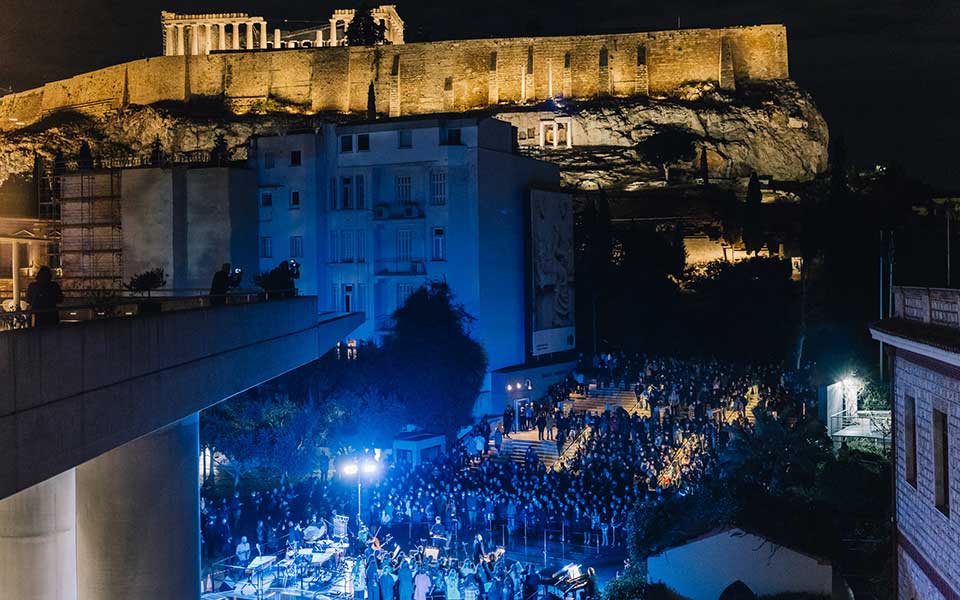As the August Full Moon approaches, the Acropolis Museum in Athens prepares to host a special cultural event that promises to captivate both locals and tourists. On Monday, August 19, the award-winning museum will open its doors for an evening of music and history, celebrating the Full Moon — a celestial event deeply significant in Greek culture.
The highlight of this year’s celebration is a concert by the renowned Hellenic Air Force Band, scheduled for 9pm in the Museum’s entrance courtyard. This performance will feature an enchanting selection of Greek songs, alongside famous film scores and international melodies. Under the baton of Major Alexandros Litsardopoulos, the Band will bring to life the magic of the moon through music, accompanied by vocalists Sofia Zova and Aggelos Mousikas.
The Hellenic Air Force Band, rooted in a tradition of excellence, is composed of senior and junior officers who are highly skilled musicians, many of whom have studied at prestigious conservatories across Greece. Over the years, the band has gained international recognition, performing at global music festivals and leading the famous 5th Avenue parade in New York during the March 25th Independence Day celebrations for the Greek expatriate community.
In addition to the concert, the Acropolis Museum will extend its opening hours, allowing visitors to explore its exhibitions from 8pm until midnight. While the concert is free of charge, standard admission fees apply for those wishing to visit the museum’s galleries. Visitors wishing to dine at the museum’s second floor restaurant can reserve their table with a free admission ticket, available at the Ticket Desk, which will remain open until 11.30pm.
The “Excavation Museum” below the Museum will be closed for the August Full Moon. For more information, please visit the Acropolis Museum website.

© Acropolis Museum
Other Free Events in Greece on August 19
Beyond the Acropolis Museum, the August Full Moon will be celebrated in Athens and across Greece with various free events.
The Hellenic Ministry of Culture is organizing its 24th annual August Full Moon event, a program coordinated by the General Directorate of Antiquities and Cultural Heritage, offering free admission to 100 archaeological and historical sites, monuments, and museums across the country. This year, additional dates have been included in the program from August 9th to 25th.
The program includes open-air concerts, theater performances, stargazing, and guided tours, organized by the services of the General Directorate of Antiquities and Cultural Heritage and the General Directorate of Restoration, Museums, and Technical Works. Many events are being organized in collaboration with local councils and community-run cultural associations.
In the region of Attica, the cultural offerings are particularly abundant, giving both locals and visitors the chance to experience the magic of the Full Moon against the backdrop of some of Greece’s lesser-known landmarks. Of particular note is the dramatic reading of excerpts from Euripides’ “Hecuba,” performed by Konstantinos Chatzis, at the Archaeological Site of Amphiareio, near Oropos. The event begins at 8.30pm.
Special events will also be held at the Archaeological Museum and the Museum of Byzantine Culture in Thessaloniki, and the Archaeological Museum of Heraklion, Crete.
For a full list of the archaeological sites and museums with extended opening hours on the night of the Full Moon, and the concerts and cultural events that will be held, a list in English published by the Ministry of Culture is available here as a downloadable spreadsheet.

© Public domain / Jean-Pol GRANDMONT
The Cultural Significance of the Moon in Ancient Greece
The August Full Moon, and the Moon in general, was a source of endless fascination for the ancient Greeks, playing a central role in the stories of several deities. Selene, the goddess of the Moon, is one of the most prominent figures in Greek mythology who, along with her siblings, the sun god Helios and the dawn goddess Eos, is one of the few Greek deities to be of Proto-Indo-European origin. She is often depicted driving a chariot across the night sky, her luminous presence symbolizing the divine feminine and the cyclical nature of time. Two of the original four horse heads from her chariot, depicted in the East pediment of the Parthenon, can be viewed in the upstairs gallery at the Acropolis Museum. Selene’s love affair with the mortal Endymion, whom she placed in eternal sleep to preserve his beauty, is one of the most poignant myths associated with the moon.
Artemis, the goddess of the hunt and wilderness, and twin sister of Apollo, is another lunar deity, often associated with the crescent Moon. As a protector of women and children, Artemis embodies the Moon’s nurturing qualities while also representing the wild, untamed aspects of nature. In many myths, Artemis is seen as a fierce and independent deity, her connection to the Moon highlighting the duality of her character — both a nurturer and a hunter.

© Shutterstock
Hecate, the goddess of witchcraft and magic, is also linked to the Moon, particularly its darker, waning phase. As a figure associated with crossroads and transitions, Hecate’s connection to the Moon emphasizes themes of change and the unknown. Her role in mythology underscores the Moon’s influence over the mystical and the unseen aspects of life.
The August Full Moon, known as the “Sturgeon Moon” in some cultures, held special significance in ancient Greece. This time of year marked the beginning of the harvest season, and the Full Moon was believed to bless the crops, ensuring a bountiful yield. It was also a period of various religious observances, where offerings were made to deities associated with fertility and the earth.












